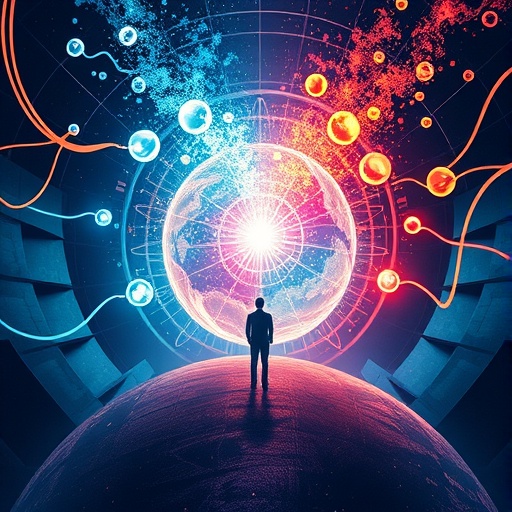The intersection between science and religion has long been a topic of intense debate and discussion, raising fundamental questions about how individuals understand the world around them. Recent research conducted by an interdisciplinary team consisting of Revell, Bowie, Woolley, and others, delves into this complex relationship, particularly focusing on the role of educators in shaping students’ perceptions. Their research, published in the Journal of Religious Education, sheds light on how the methods used by teachers in formulating questions can deeply influence the dynamics of learning in the context of science and religion.
The authors argue that the manner in which questions are posed in educational settings plays a critical role in facilitating or hindering a robust inquiry into scientific and religious concepts. They draw upon the theories of renowned sociologist Basil Bernstein, who is known for his work on codes of communication and how they affect educational processes. Bernstein’s theories are instrumental in understanding the complexities of classroom communication, especially in subjects as multifaceted as science and religious studies.
The research highlights that questions are not merely tools for assessment but are also vehicles for cultivating critical thinking and encouraging students to engage in meaningful dialogue. The educators’ ability to frame questions can lead students to explore the deeper meanings of both scientific theories and religious beliefs, nudging them towards a more nuanced understanding of both fields. This pedagogical approach not only fosters academic growth but also enhances students’ emotional and social intelligence, equipping them with skills essential for navigating an increasingly complicated world.
As the research unfolds, it becomes apparent that teachers often encounter the challenges posed by students’ preconceived notions regarding science and religion. Many students arrive in classrooms with entrenched beliefs that can conflict with scientific principles, leading to cognitive dissonance. The authors emphasize the significance of addressing these conflicts head-on, utilizing carefully crafted questions as a means to bridge the divide between faith and empirical evidence. This approach promotes a learning environment where students feel safe to explore controversial topics without fear of reprimand or dismissal.
Moreover, the study indicates that the engagement level of students can significantly increase when questions are directed towards their personal experiences and beliefs. Questions that encourage reflection on individual faith or scientific understanding can transform a traditional classroom into a dynamic space of collaboration and shared inquiry. By employing methodologies that acknowledge the emotional and spiritual dimensions of learning, educators can guide students toward a richer understanding of how science and religion interact in their lives.
A vital aspect of the research is the identification of what the authors term “the impossibility of the unthinkable.” This phrase encapsulates the challenges faced by individuals attempting to reconcile conflicting paradigms. Bernstein’s theories point out that certain beliefs can be deeply ingrained, often limiting the capacity of individuals to critically assess their viewpoints. The researchers argue that understanding this concept is crucial for educators who wish to facilitate more profound discussions that transcend traditional boundaries.
The implications of this research extend beyond the classroom walls. As societies become more polarized on issues intersecting science and religion, the methods employed by educators can serve as a template for broader societal dialogue. By fostering inquiry-based approaches that value diverse perspectives, educators can contribute to social cohesion and mutual understanding. This is particularly pertinent in an era where misinformation can spread rapidly, and critical thinking skills are more essential than ever.
Additionally, the study presents various examples of successful teaching strategies that have emerged from these findings. For instance, incorporating debate formats encourages students to articulate their thoughts and engage with opposing viewpoints constructively. This method not only reinforces learning but also nurtures respect for differing beliefs. By modeling productive discussions within the classroom, educators can inspire students to carry these skills into their communities, fostering a culture of open-mindedness.
Another noteworthy contribution of the research is the focus on teacher training and development. The authors suggest that teacher education programs should emphasize the importance of question formulation as a critical pedagogical skill. By equipping future educators with the tools to navigate sensitive topics, they can be better prepared to foster environments conducive to inquiry-based learning. This proactive stance can help alleviate some of the tension that often accompanies discussions of science and religion.
In conclusion, the explorations conducted by Revell, Bowie, Woolley, and their colleagues provide valuable insights into the role of educators in shaping students’ understanding of science and religion. By employing thoughtful questioning techniques and acknowledging the emotional dimensions of learning, teachers can facilitate dialogues that transcend traditional binaries. This research invites educators to reconsider their practices and highlights the transformative potential of education in navigating the complexities of faith and empirical understanding.
As the boundaries between science and religion continue to be challenged in contemporary discourse, findings such as these serve as reminders of the pivotal role educational frameworks play in guiding future generations. The research reinforces the idea that learning is not merely an academic exercise but a profound journey of self-discovery and societal engagement. In an age where critical dialogue is paramount, the role of educators as facilitators of such discussions may prove to be one of the most significant endeavors of all.
Subject of Research: The role of educators in facilitating inquiry into the relationship between science and religion.
Article Title: Teachers’ use of questions and the science/religion encounter: Basil Bernstein and the impossibility of the unthinkable.
Article References: Revell, L., Bowie, B., Woolley, M. et al. Teachers’ use of questions and the science/religion encounter: Basil Bernstein and the impossibility of the unthinkable. j. relig. educ. 72, 295–309 (2024). https://doi.org/10.1007/s40839-024-00245-0
Image Credits: AI Generated
DOI:
Keywords: Education, Science and Religion, Inquiry, Pedagogy, Critical Thinking, Basil Bernstein.




